A Method of Multi-Stage Reservoir Water Level Forecasting Systems: A Case Study of Techi Hydropower in Taiwan
Abstract
1. Introduction
2. Techi Reservoir in Taiwan
3. The Design of Reservoir Water Level Forecasting System
3.1. The Architecture of Fuzzy Neural Networks
3.2. The 48-h Ahead Reservoir Water Level Forecasting System
4. Analysis, Results and Discussions
4.1. The Relationship between Water Level, Inflow and Rainfall of Techi Reservoir
4.2. Design of Neural Network of Water Level and Reservoir Inflow
4.3. Correlation Analysis of Reservoir Water Level and Meteorological Rainfall Data from TTFRI in Catchment Area
4.4. Experimental Results
4.5. Discussions
5. Conclusions
Author Contributions
Funding
Institutional Review Board Statement
Informed Consent Statement
Data Availability Statement
Conflicts of Interest
References
- Mendes, C.A.B.; Beluco, A.; Canales, F.A. Some important uncertainties related to climate change in projections for the Brazilian hydropower expansion in the Amazon. Energy 2017, 141, 123–138. [Google Scholar] [CrossRef]
- Amjath-Babu, T.S.; Sharma, B.; Brouwer, R.; Rasul, G.; Wahid, S.M.; Neupane, N.; Bhattarai, U.; Sieber, S. Integrated modelling of the impacts of hydropower projects on the water-food-energy nexus in a transboundary Himalayan river basin. Appl. Energy 2019, 239, 494–503. [Google Scholar] [CrossRef]
- Turner, S.W.D.; Hejazi, M.; Kim, S.H.; Clarke, L.; Edmonds, J. Climate impacts on hydropower and consequences for global electricity supply investment needs. Energy 2017, 141, 2081–2090. [Google Scholar] [CrossRef]
- Voisin, N.; Dyreson, A.; Fu, T.; O’Connell, M.; Turner, S.W.; Zhou, T.; Macknick, J. Impact of climate change on water availability and its propagation through the Western U.S. power grid. Appl. Energy 2020, 276, 115467. [Google Scholar] [CrossRef]
- Tarroja, B.; Forrest, K.; Chiang, F.; AghaKouchak, A.; Samuelsen, S. Implications of hydropower variability from climate change for a future, highly-renewable electric grid in California. Appl. Energy 2019, 237, 353–366. [Google Scholar] [CrossRef]
- Nohara, D.; Hori, T.; Sato, Y. Real-time reservoir operation for drought management considering operational ensemble predictions of precipitation in Japan. In Advances in Hydroinformatics; Springer: Singapore, 2018; pp. 331–345. [Google Scholar] [CrossRef]
- Faber, B.A.; Stedinger, J.R. Reservoir optimization using sampling SDP with ensemble streamflow prediction (ESP) forecasts. J. Hydrol. 2001, 249, 113–133. [Google Scholar] [CrossRef]
- Alemu, E.T.; Palmer, R.N.; Polebitski, A.; Meaker, B. Decision support system for optimizing reservoir operations using ensemble streamflow predictions. J. Water Resour. Plan. Manag. 2011, 137, 72–82. [Google Scholar] [CrossRef]
- Cheng, C.T.; Feng, Z.K.; Niu, W.J.; Liao, S.L. Heuristic methods for reservoir monthly inflow forecasting: A case study of Xinfengjiang Reservoir in Pearl River. Water 2015, 7, 4477–4495. [Google Scholar] [CrossRef]
- Wang, H.; Xiao, W.; Wang, Y.; Zhao, Y.; Lu, F.; Yang, M.; Hou, B.; Yang, H. Assessment of the impact of climate change on hydropower potential in the Nanliujiang river basin of China. Energy 2019, 167, 950–959. [Google Scholar] [CrossRef]
- Gupta, A.; Kumar, A.; Khatod, D.K. Optimized scheduling of hydropower with increase in solar and wind installations. Energy 2019, 183, 716–732. [Google Scholar] [CrossRef]
- Llamosas, C.; Sovacool, B.K. The future of hydropower? A systematic review of the drivers, benefits and governance dynamics of transboundary dams. Renew. Sustain. Energy Rev. 2020, 137, 110495. [Google Scholar] [CrossRef]
- Kuo, C.-C.; Gan, T.Y.; Yu, P.-S. Seasonal streamflow prediction by a combined climate-hydrologic system for river basins of Taiwan. J. Hydrol. 2010, 387, 292–303. [Google Scholar] [CrossRef]
- Le, V.T.; Kuo, C.-M.; Yang, T.-C. Application of Non-Dominated Sorting Genetic Algorithm in Calibration of HBV Rainfall-Runoff Model: A Case Study of Tsengwen Reservoir Catchment in Southern Taiwan. In Proceedings of the 12th International Conference on Hydroscience & Engineering, Tainan, Taiwan, 6–10 November 2016. [Google Scholar]
- Leu, Y.G.; Lee, T.T.; Wang, W.Y. Observer-based adaptive fuzzy-neural control for unknown nonlinear dynamical systems. IEEE Trans. Syst. Man Cybern. Part B 1999, 29, 583–591. [Google Scholar] [CrossRef]
- Wang, W., Zhao, X., Eds.; A new model of fuzzy neural networks and its application. In Proceedings of the Fifth World Congress on Intelligent Control and Automation (IEEE Cat No 04EX788), Hangzhou, China, 15–19 June 2004. [Google Scholar]
- Maier, H.R.; Dandy, G.C. Neural networks for the prediction and forecasting of water resources variables: A review of modelling issues and applications. Environ. Model. Softw. 2000, 15, 101–124. [Google Scholar] [CrossRef]
- Termite, L.F.; Todisco, F.; Vergni, L.; Mannocchi, F. A neuro-fuzzy model to predict the inflow to the guardialfiera multipurpose dam (Southern Italy) at medium-long time scales. J. Agric. Eng. 2013, 44. [Google Scholar] [CrossRef][Green Version]
- Ishak, W.W.; Mahamud, K.R.K.; Norwawi, N.M. Modelling reservoir water release decision using temporal data mining and neural network. Int. J. Emerg. Technol. Adv. Eng. 2012, 2, 422–428. [Google Scholar]
- Ashaary, N.A.; Wan, I.W.H.; Ku-Mahamud, K.R. Forecasting model for the change of reservoir water level stage based on temporal pattern of reservoir water level. In Proceedings of the 5th International Conference on Computing and Informatics, Istanbul, Turkey, 11–13 August 2015. [Google Scholar]
- Wan, I.W.H.; Ku-Mahamud, K.R.; Md, N.N. Modelling of human expert decision making in reservoir operation. J. Teknol. 2015, 77, 1–5. [Google Scholar]
- Ashaary, N.A.; Wan, I.W.H.; Ku-Mahamud, K.R. Neural network application in the change of reservoir water level stage forecasting. Indian J. Sci. Technol. 2015, 8, 1–6. [Google Scholar] [CrossRef]
- Mekanik, F.; Imteaz, M.; Gato-Trinidad, S.; Elmahdi, A. Multiple regression and Artificial Neural Network for long-term rainfall forecasting using large scale climate modes. J. Hydrol. 2013, 503, 11–21. [Google Scholar] [CrossRef]
- Akhtar, M.; Corzo, G.; Van Andel, S.; Jonoski, A. River flow forecasting with artificial neural networks using satellite observed precipitation pre-processed with flow length and travel time information: Case study of the Ganges river basin. Hydrol. Earth Syst. Sci. 2009, 13, 1607–1618. [Google Scholar] [CrossRef]
- Rasouli K, Hsieh WW, Cannon AJ. Daily streamflow forecasting by machine learning methods with weather and climate inputs. J. Hydrol. 2012, 414, 284–293. [Google Scholar]
- Lee, C.S. The Analysis and Numerical Simulation of Typhoons Invading Taiwan from the South (I); Research Report of the National Science Council: Taipei, Taiwan, 2005. [Google Scholar]
- Lee, C.S.; Fang, W.T.; Hwang, L.R. The Development of Integrated Quantitative Precipitation Forecasting Technique for Typhoon; Research Report of Central Weather Bureau: Taipei, Taiwan, 2009. [Google Scholar]
- Chen, Y.C.; Chang, L.Y.; Hsiao, L.F.; Chiang, C.C.; Tsai, C.C.; Wang, C.J. Quantitative precipitation forecasting technology in Taiwan. In Proceedings of the 2012 Conference on Weather Analysis and Forecasting, Taipei, Taiwan,, 17–20 September 2012. [Google Scholar]
- Chiang, C.C.; Chen, Y.C.; Hwang, L.R.; Wu, M.Z.; Feng, L.; Lee, C.S. 2013 Taiwan Quantitative Rainfall Prediction Experimental Platform (TAPEX) in the path and rainfall performance evaluation. In Proceedings of the 2014 Conference on Weather Analysis and Forecasting, Taipei, Taiwan, 16–18 September 2014. [Google Scholar]
- Chen, Y.C. A Study of Typhoon Structure and Quantitative Precipitation Forecast by Using High Resolution Ensemble Models; Research Report of the National Science Council: Taipei, Taiwan, 2013. [Google Scholar]
- Lee, C.S.; Ho, H.Y.; Lee, K.T.; Wang, Y.C.; Guo, W.D.; Chen, D.Y.C.; Hsiao, L.F.; Hsiao, L.-F.; Chiang, C.-C.; Yang, M.-J.; et al. Assessment of sewer flooding model based on ensemble quantitative precipitation forecast. J. Hydrol. 2013, 506, 101–113. [Google Scholar] [CrossRef]
- Yang, S.-C.; Yang, T.-H. Uncertainty Assessment: Reservoir Inflow Forecasting with Ensemble Precipitation Forecasts and HEC-HMS. Adv. Meteorol. 2014, 2014, 581756. [Google Scholar] [CrossRef]
- Chang, L.Y.; Hsiao, L.F.; Chen, D.Y.C.; Yang, M.J.; Tsai, C.C.; Wang, C.J. Ensemble Forecast Experiment for Typhoon Quantitatively Precipitation in Taiwan. Weather Forecast. 2014, 30, 217–237. [Google Scholar]
- Bras, R.L.; Rodriguez, I. Random Functions and Hydrology; Courier Corporation: Chelmsford, MA, USA, 1993. [Google Scholar]
- Kitanidis, P.K. Geostatistics. In Handbook of Hydrology; Maidment, D.R., Ed.; McGraw-Hill: New York, NU, USA, 1993. [Google Scholar]
- Michalakes, J. Design of a next-generation regional weather research and forecast model. Argonne Natl. Lab 1999. [Google Scholar] [CrossRef]
- Burn, D.H. Climatic influences on streamflow timing in the headwaters of the Mackenzie River Basin. J. Hydrol. 2008, 352, 225–238. [Google Scholar] [CrossRef]
- Cannon, A.J.; Whitfield, P.H. Downscaling recent streamflow conditions in British Columbia, Canada using ensemble neural network models. J. Hydrol. 2002, 259, 136–151. [Google Scholar] [CrossRef]
- Yang, T.C.; Yu, P.S.; Chen, C.C. Long-term runoff forecasting by combining hydrological models and meteorological records. Hydrol. Process. Int. J. 2005, 19, 1967–1981. [Google Scholar] [CrossRef]
- Yu, P.-S.; Yang, T.-C. Fuzzy multi-objective function for rainfall-runoff model calibration. J. Hydrol. 2000, 238, 1–14. [Google Scholar] [CrossRef]
- Shang, Y.; Xu, Y.; Shang, L.; Fan, Q.; Wang, Y.; Liu, Z. A method of direct, real-time forecasting of downstream water levels via hydropower station reregulation: A case study from Gezhouba Hydropower Plant, China. J. Hydrol. 2019, 573, 895–907. [Google Scholar] [CrossRef]
- Chiang, Y.-M.; Chang, L.-C.; Chang, F.-J. Comparison of static-feedforward and dynamic-feedback neural networks for rainfall–runoff modeling. J. Hydrol. 2004, 290, 297–311. [Google Scholar] [CrossRef]
- Hammid, A.T.; Sulaiman, M.H.B.; Abdalla, A.N. Prediction of small hydropower plant power production in Himreen Lake dam (HLD) using artificial neural network. Alex. Eng. J. 2018, 57, 211–221. [Google Scholar] [CrossRef]
- Dehghani, M.; Riahi-Madvar, H.; Hooshyaripor, F.; Mosavi, A.; Shamshirband, S.; Zavadskas, E.K.; Chau, K.W. Prediction of Hydropower Generation Using Grey Wolf Optimization Adaptive Neuro-Fuzzy Inference System. Energies 2019, 12, 289. [Google Scholar] [CrossRef]
- Water Resources Agency, MOEA. Available online: https://www.wra.gov.tw/News_Content.aspx?n=3254&s=19375 (accessed on 30 September 2020).
- Leu, Y.G.; Wang, W.Y.; Lee, T.T. Observer-Based Direct Adaptive Fuzzy-Neural Control for Nonaffine Nonlinear Systems. IEEE Trans. Neural Netw. 2005, 16, 853–861. [Google Scholar] [CrossRef] [PubMed]
- Wang, L.X. Adaptive Fuzzy Systems and Control: Design and Stability Analysis; Prentice-Hall: Englewood Cliffs, NJ, USA, 1994. [Google Scholar]
- Michalakes, J.; Chen, S.; Dudhia, J.; Hart, L.; Klemp, J.; Middlecoff, J.; Skamarock, W. Development of a next-generation regional weather research and forecast model. In Developments in Teracomputing; World Scientific: Singapore, 2001; pp. 269–276. [Google Scholar]
- Falk, A.K.; Butts, M.; Madsen, H.E.N.R.I.K.; Hartnack, J.N. Data assimilation to improve forecast quality of river basin models. In Proceedings of the XVI International Conference on Computational Methods in Water Resource, Copenhagen, Denmark,, 18–22 June 2006. [Google Scholar]
- Typhoon Database. Available online: https://rdc28.cwb.gov.tw/ (accessed on 18 September 2020).

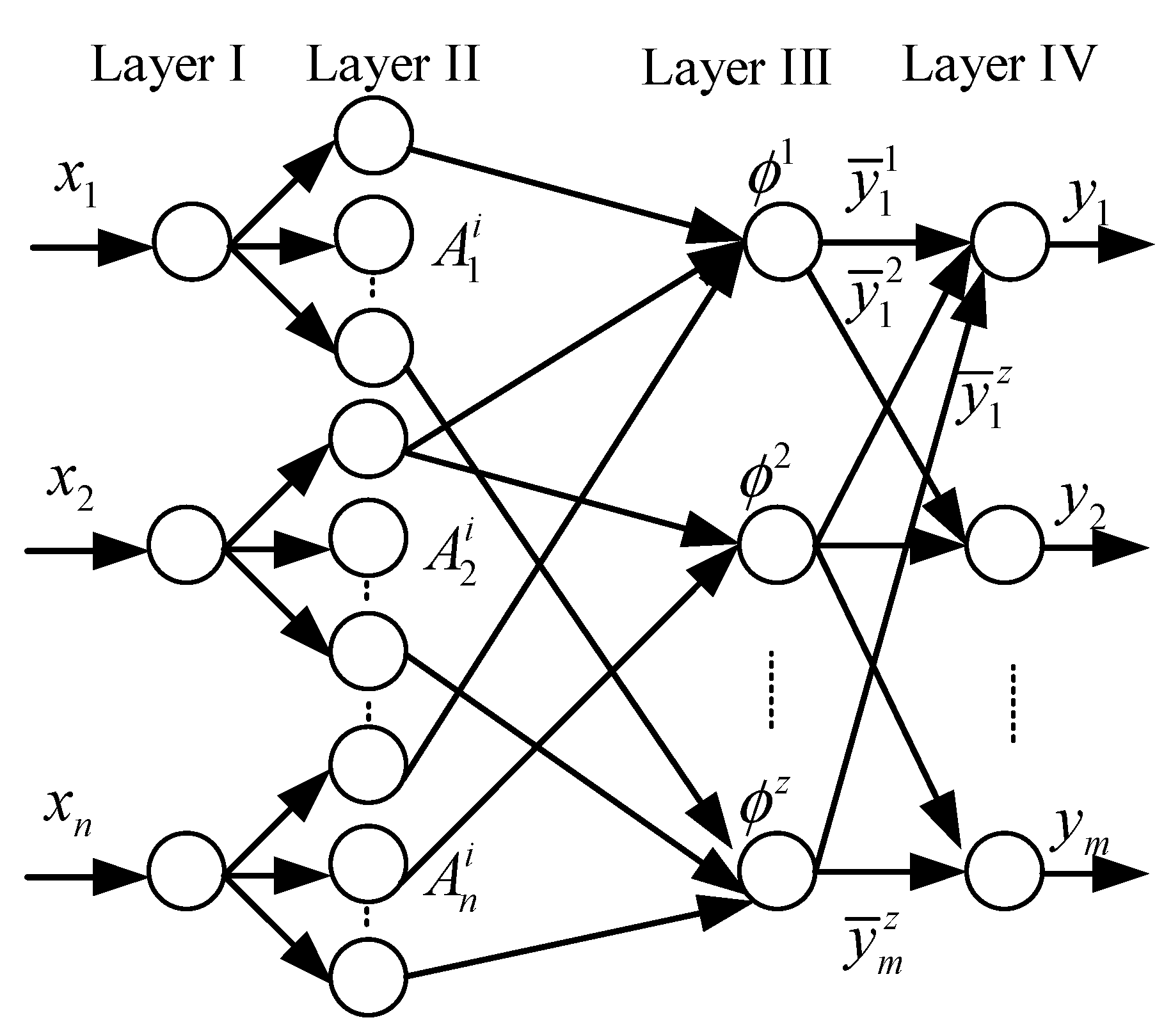

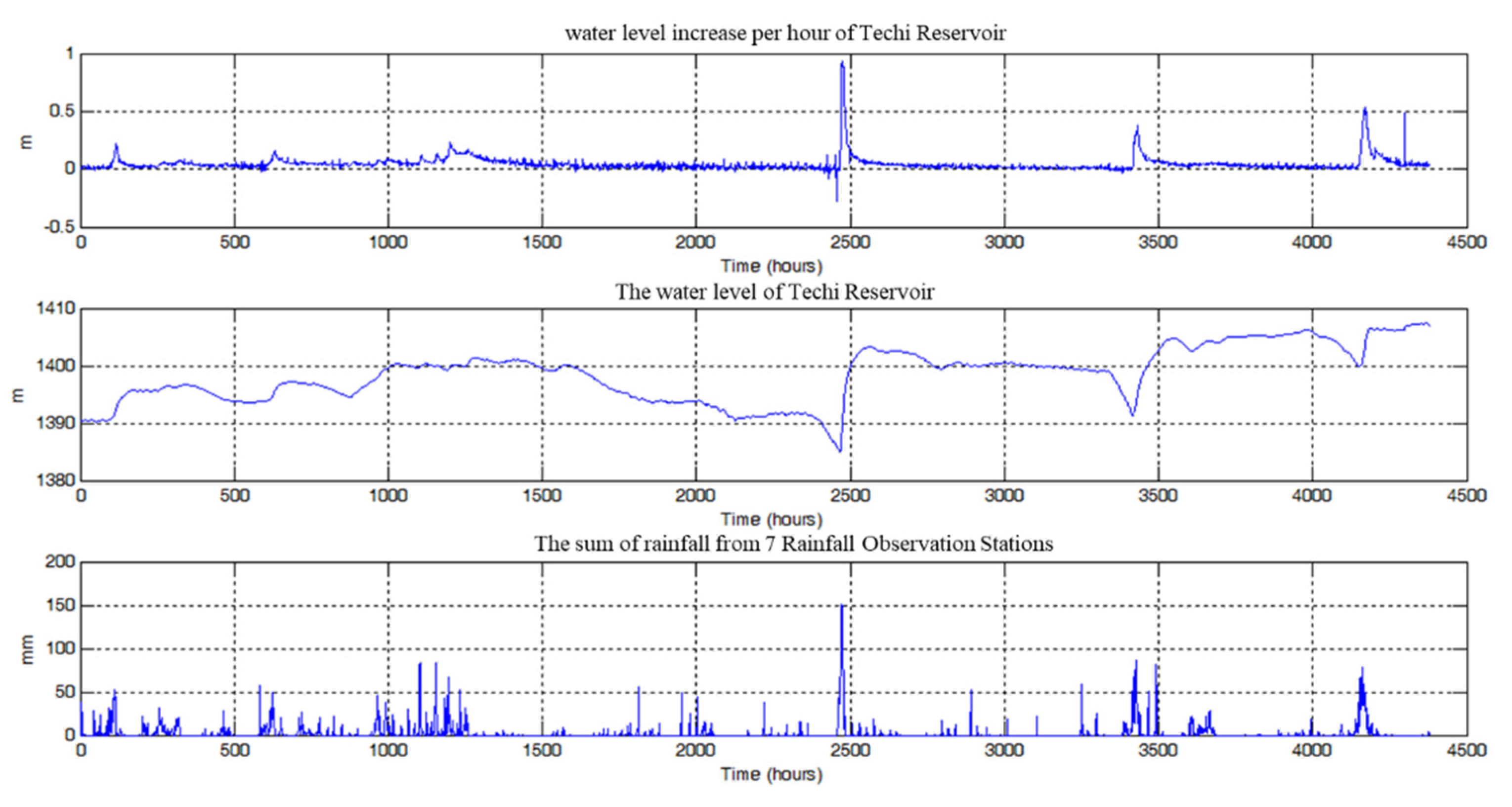
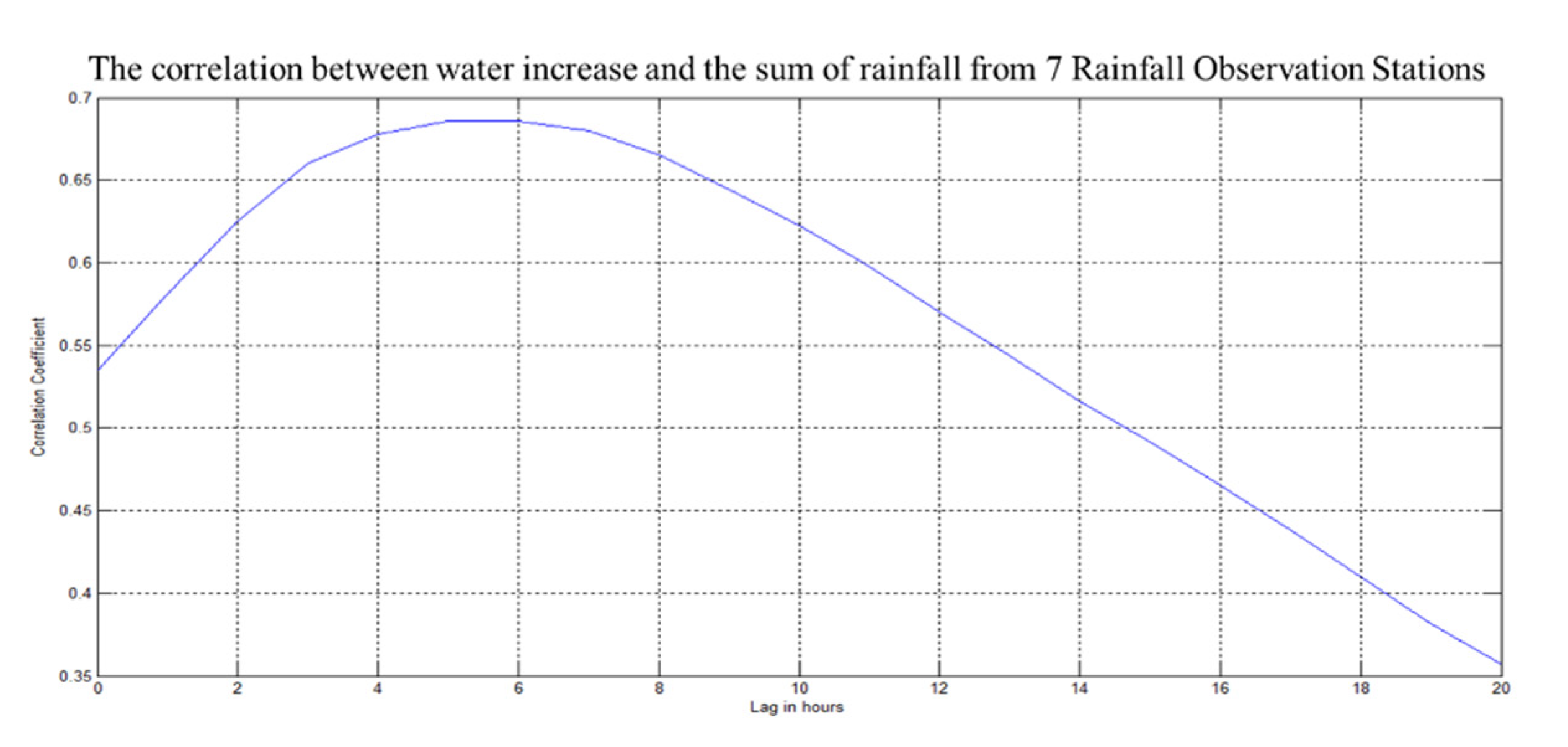
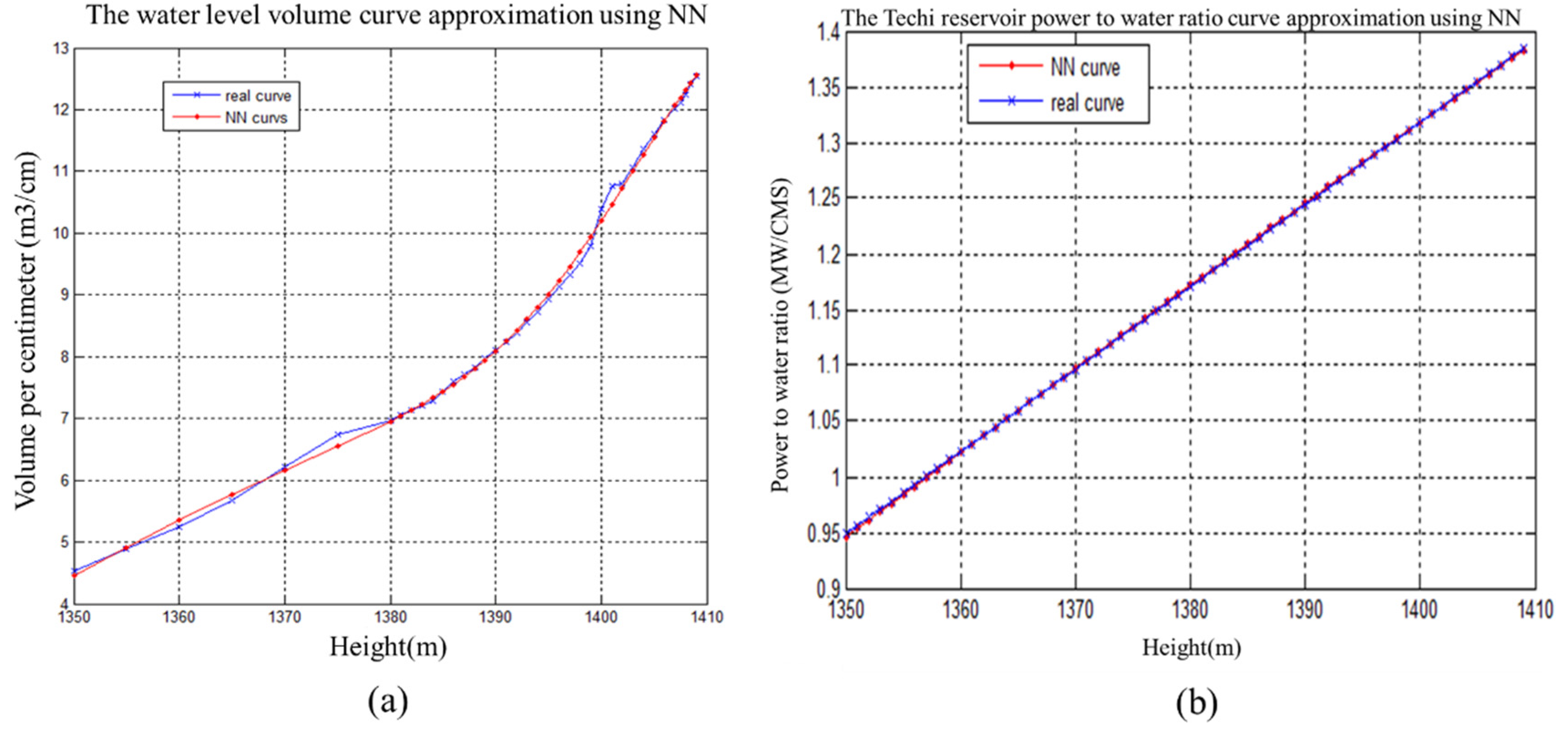
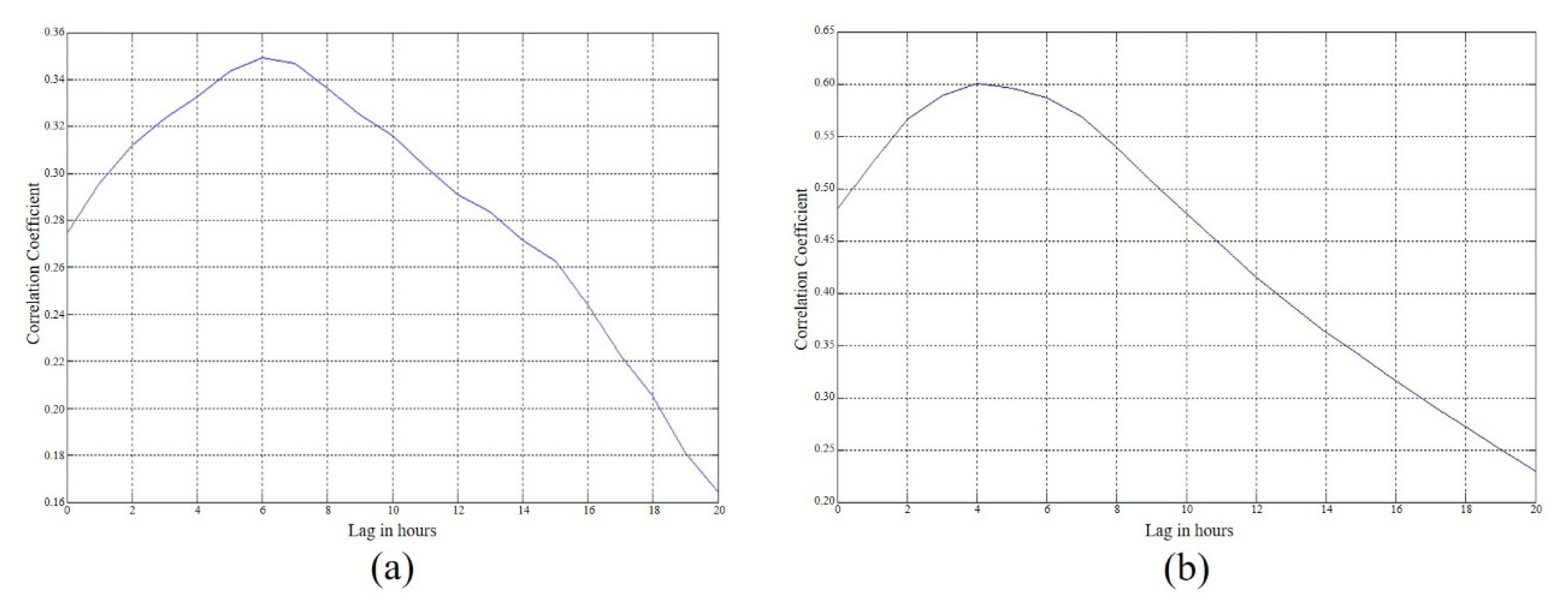
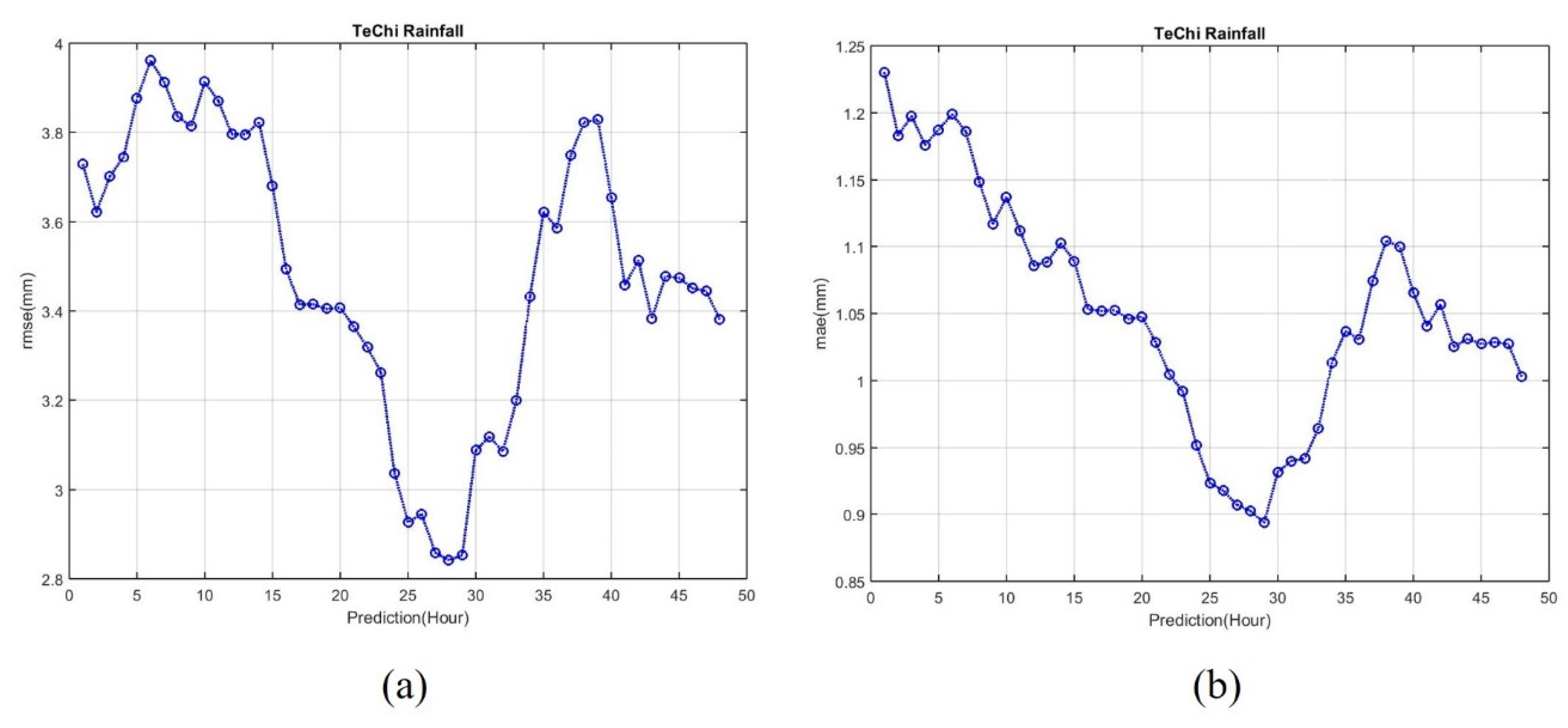
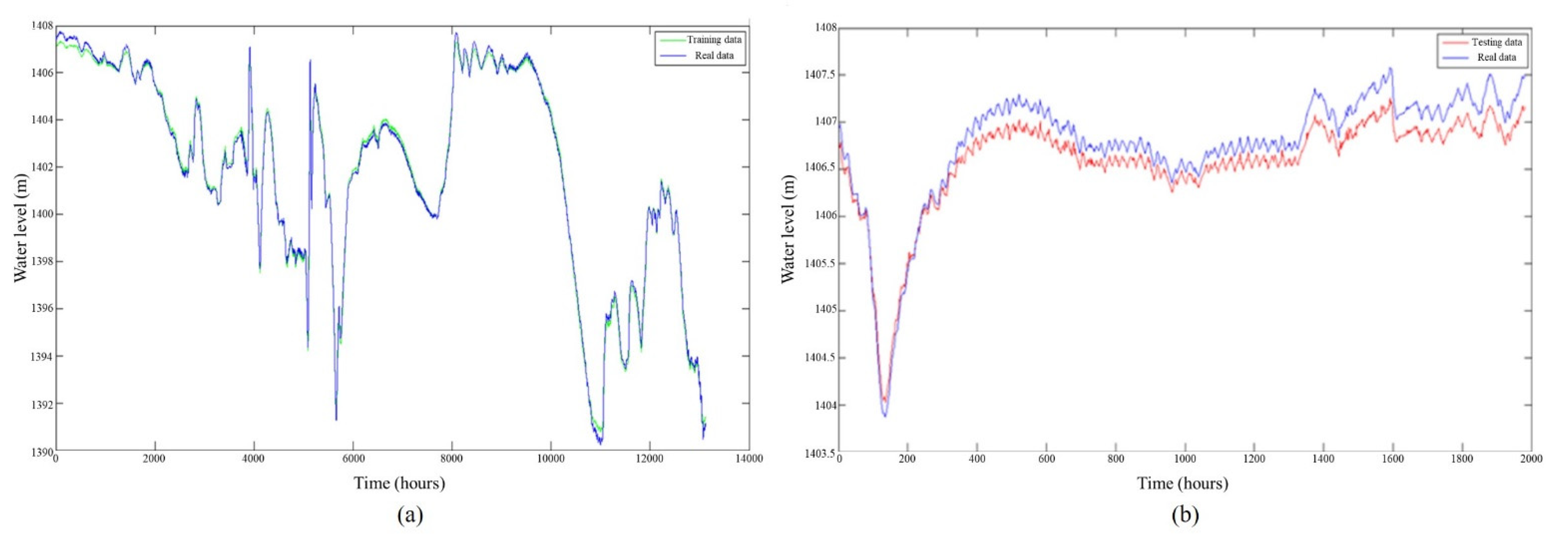
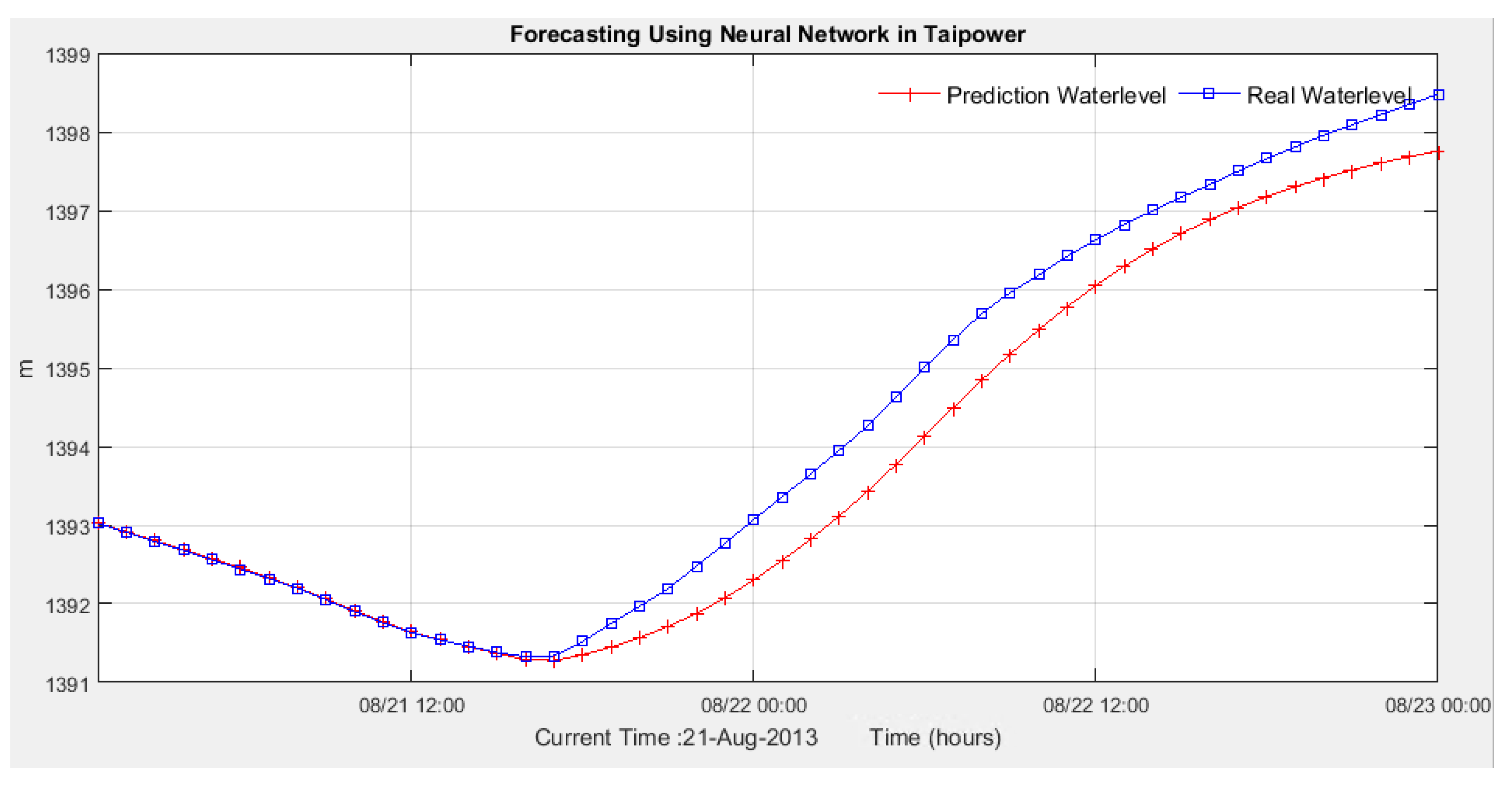
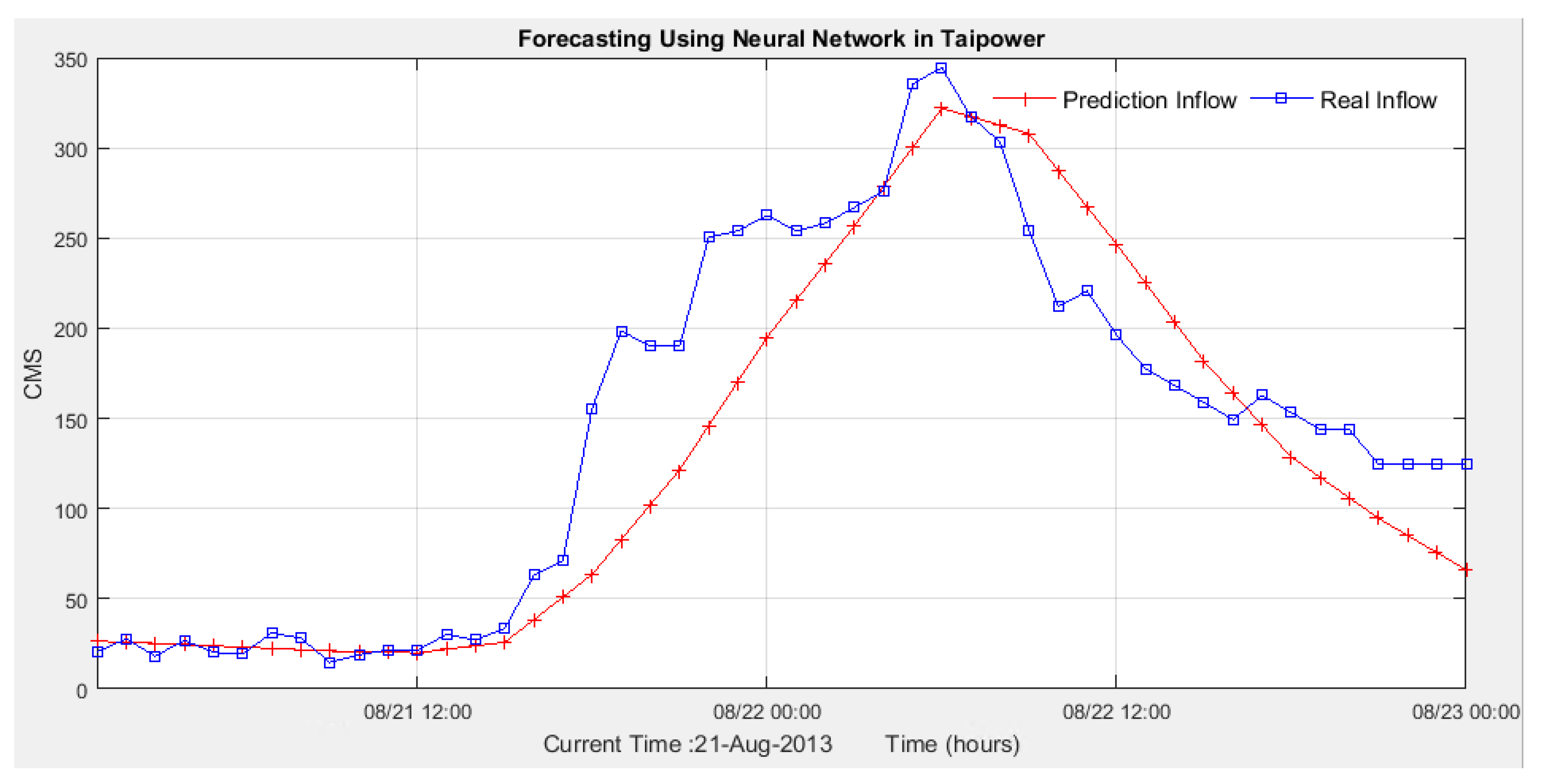
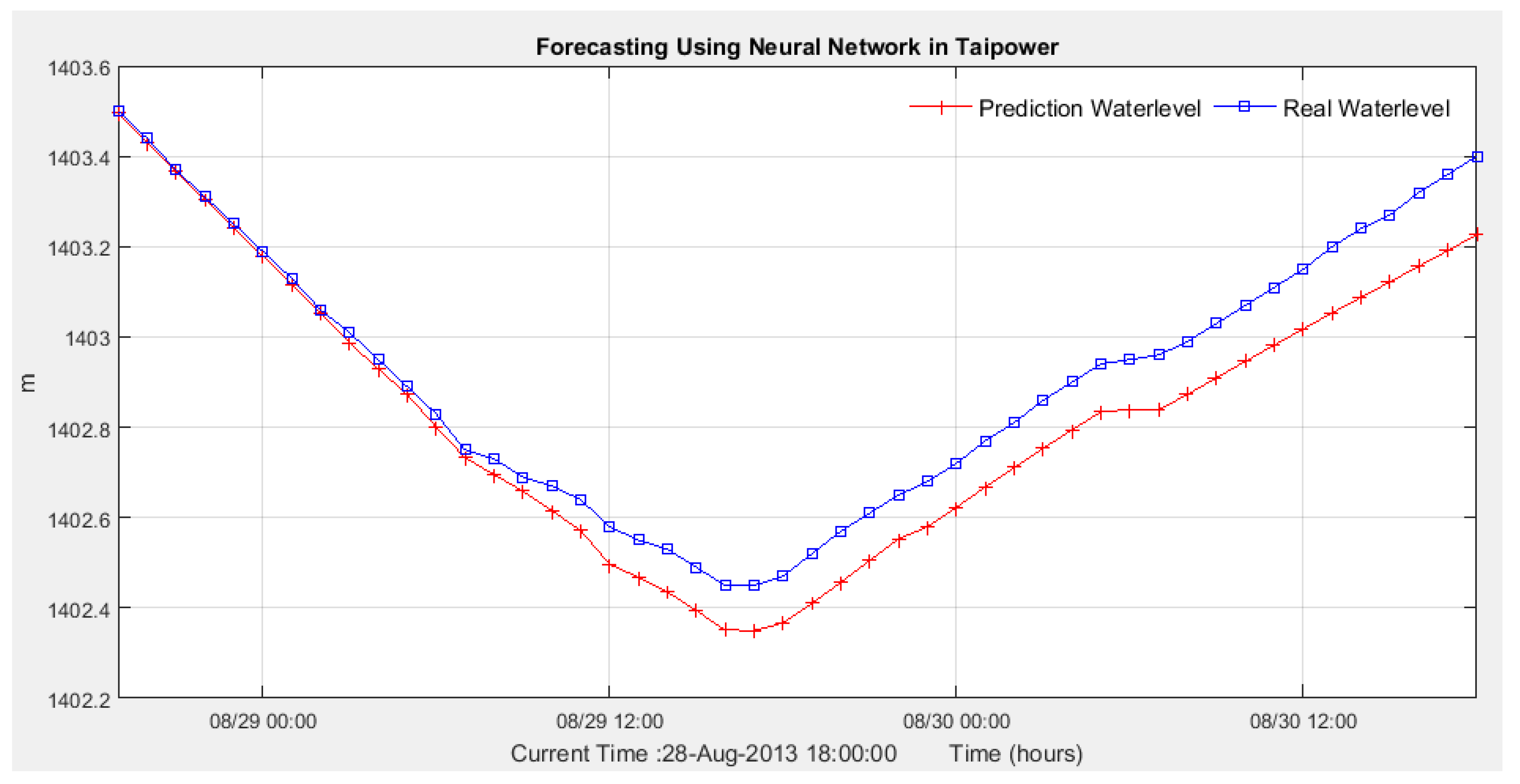
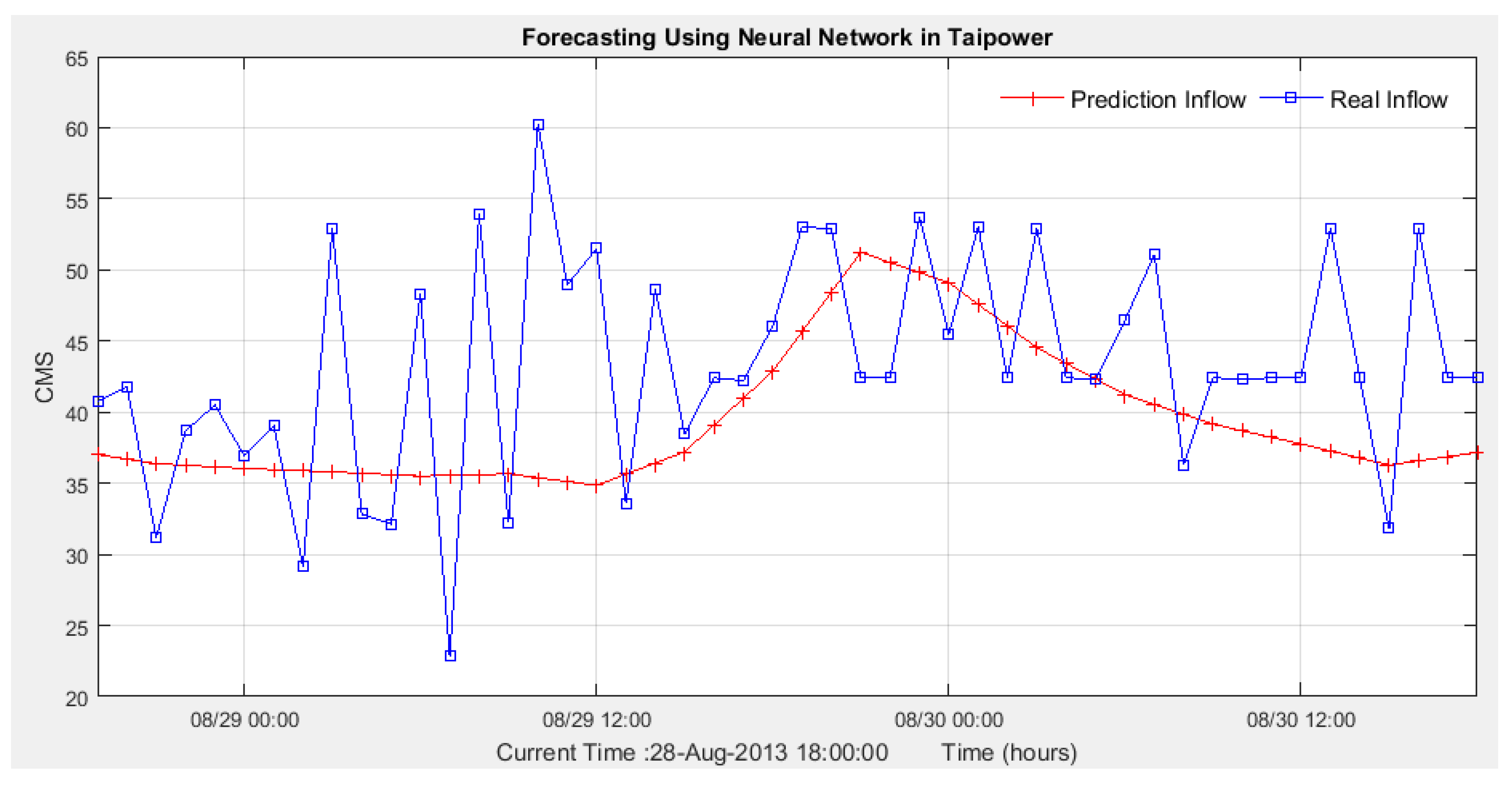
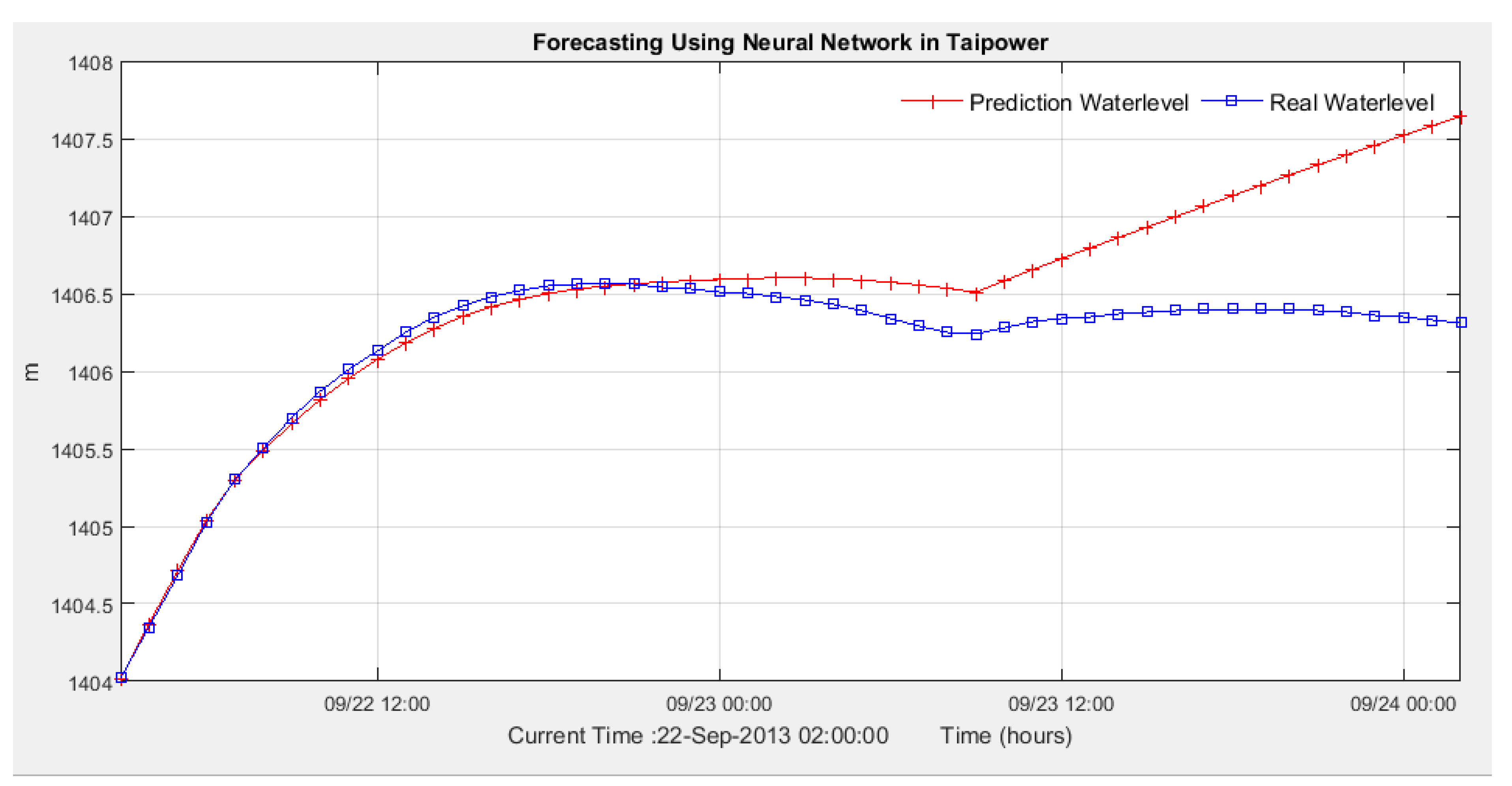


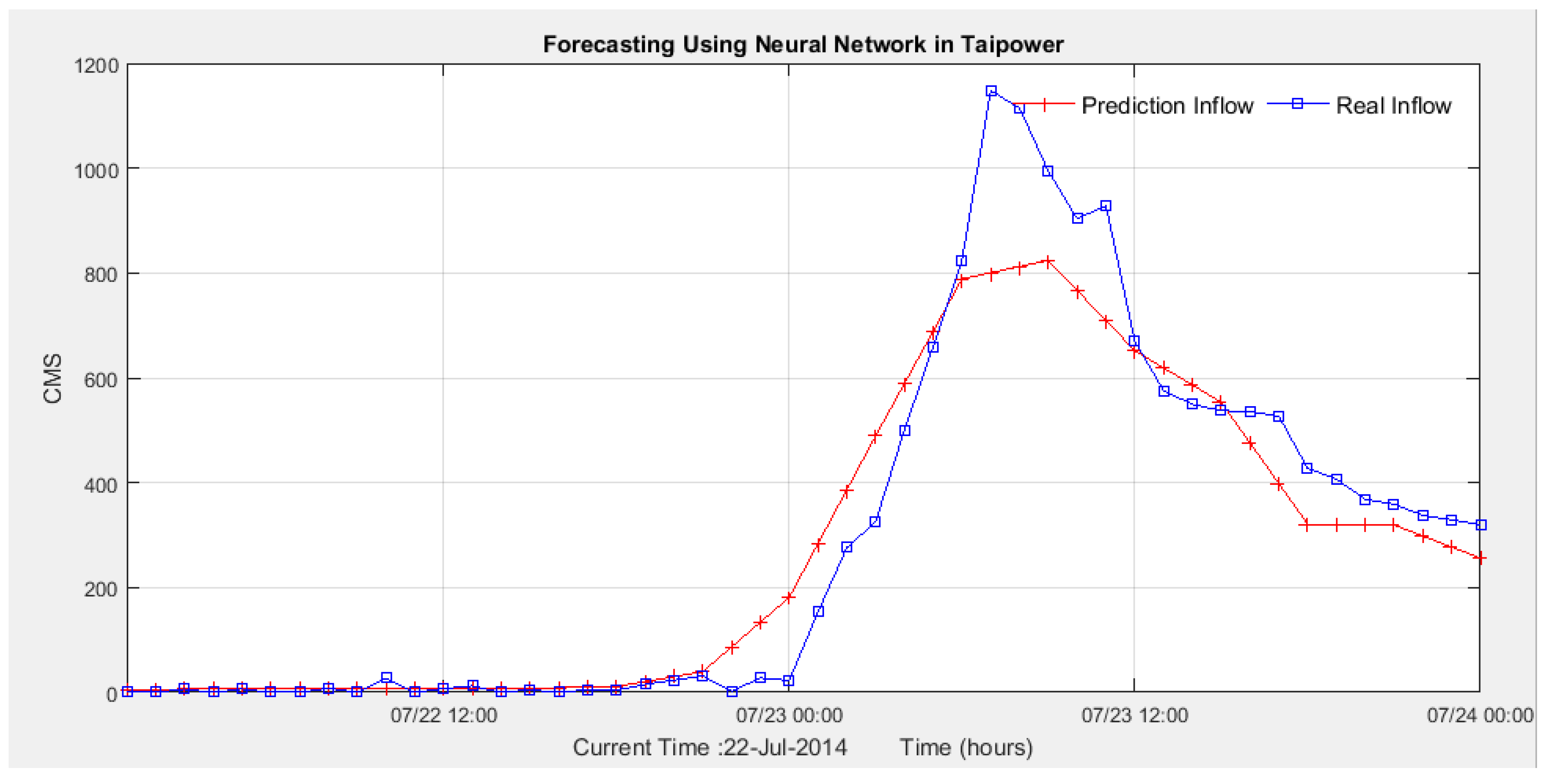
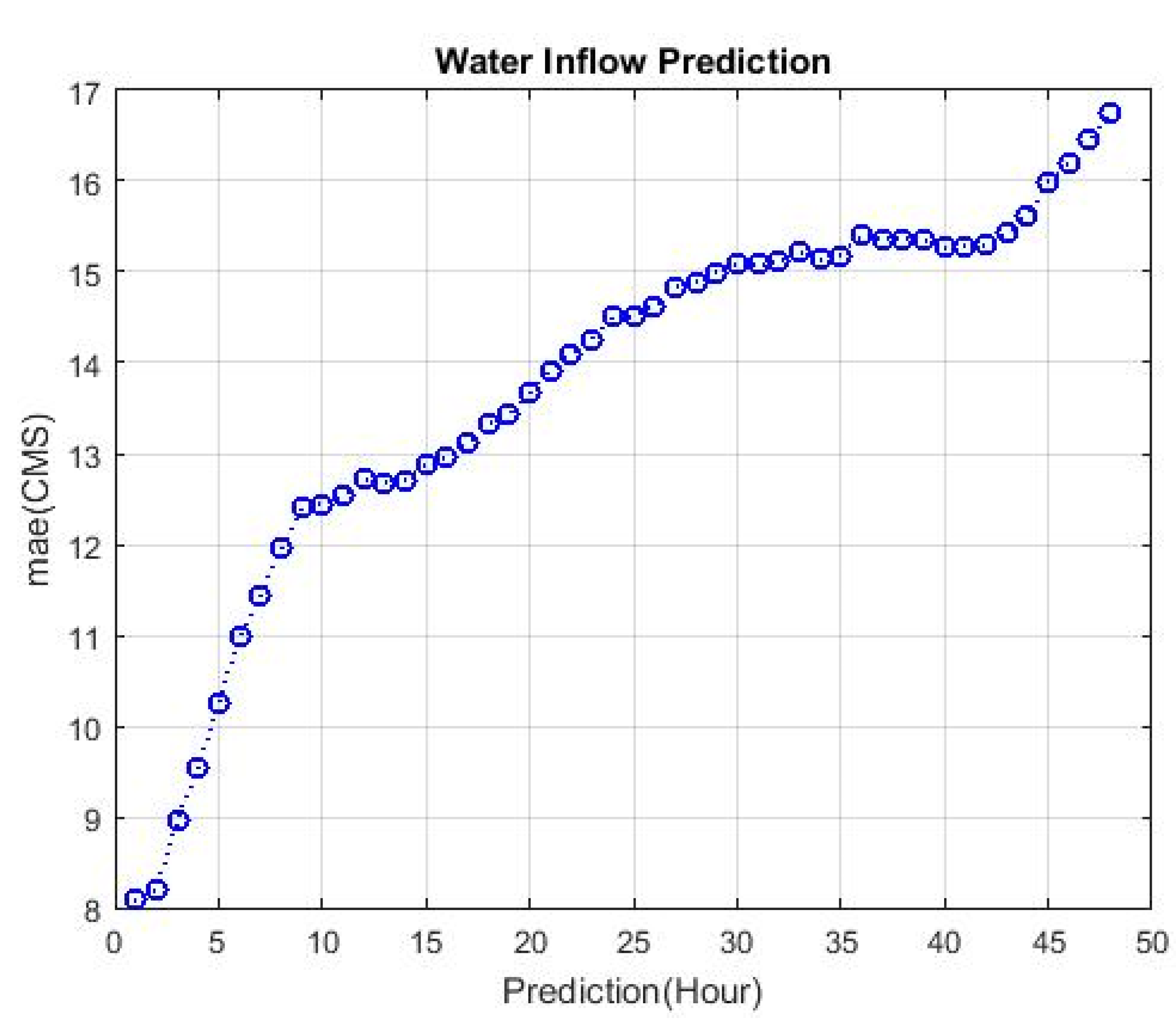
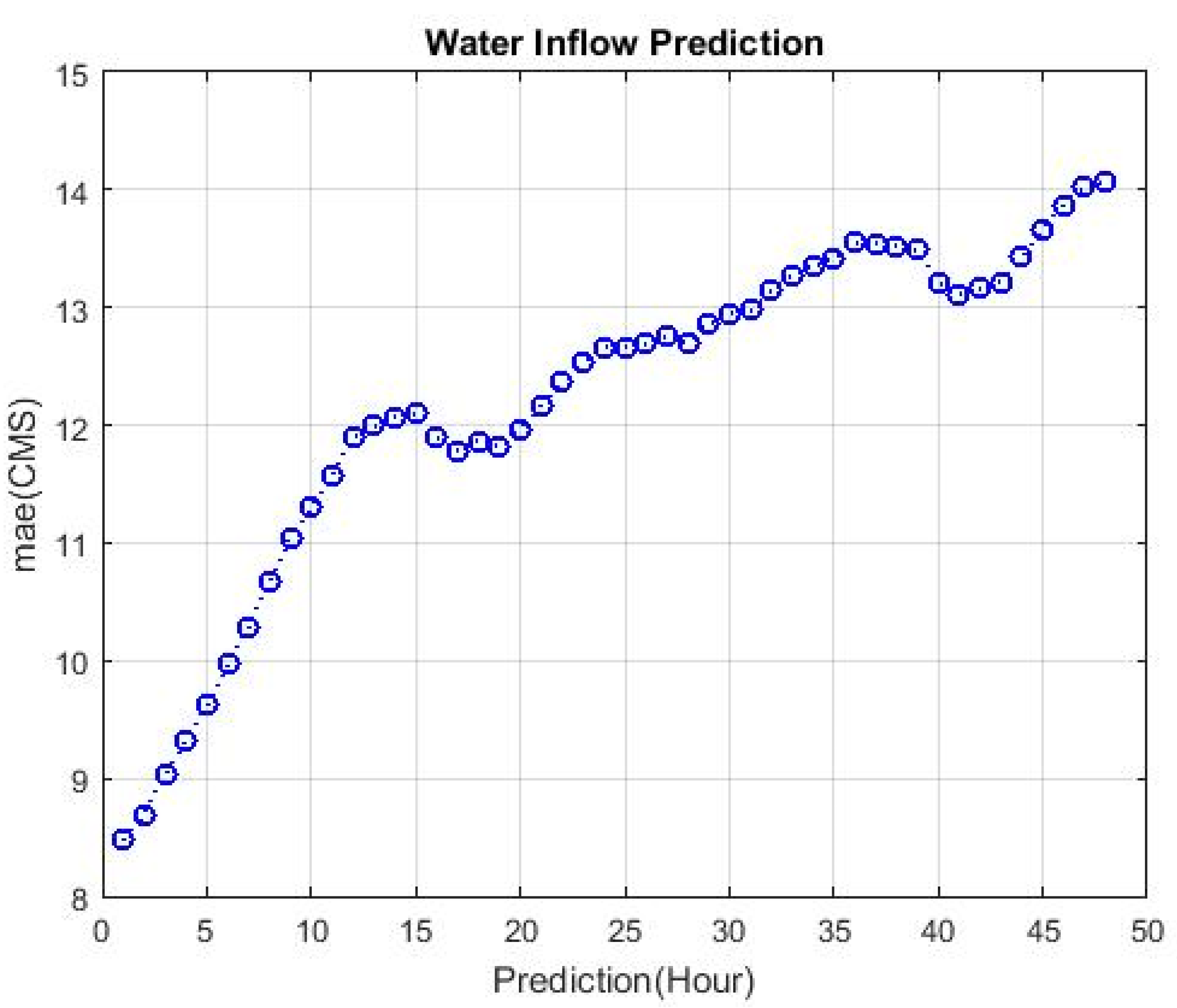
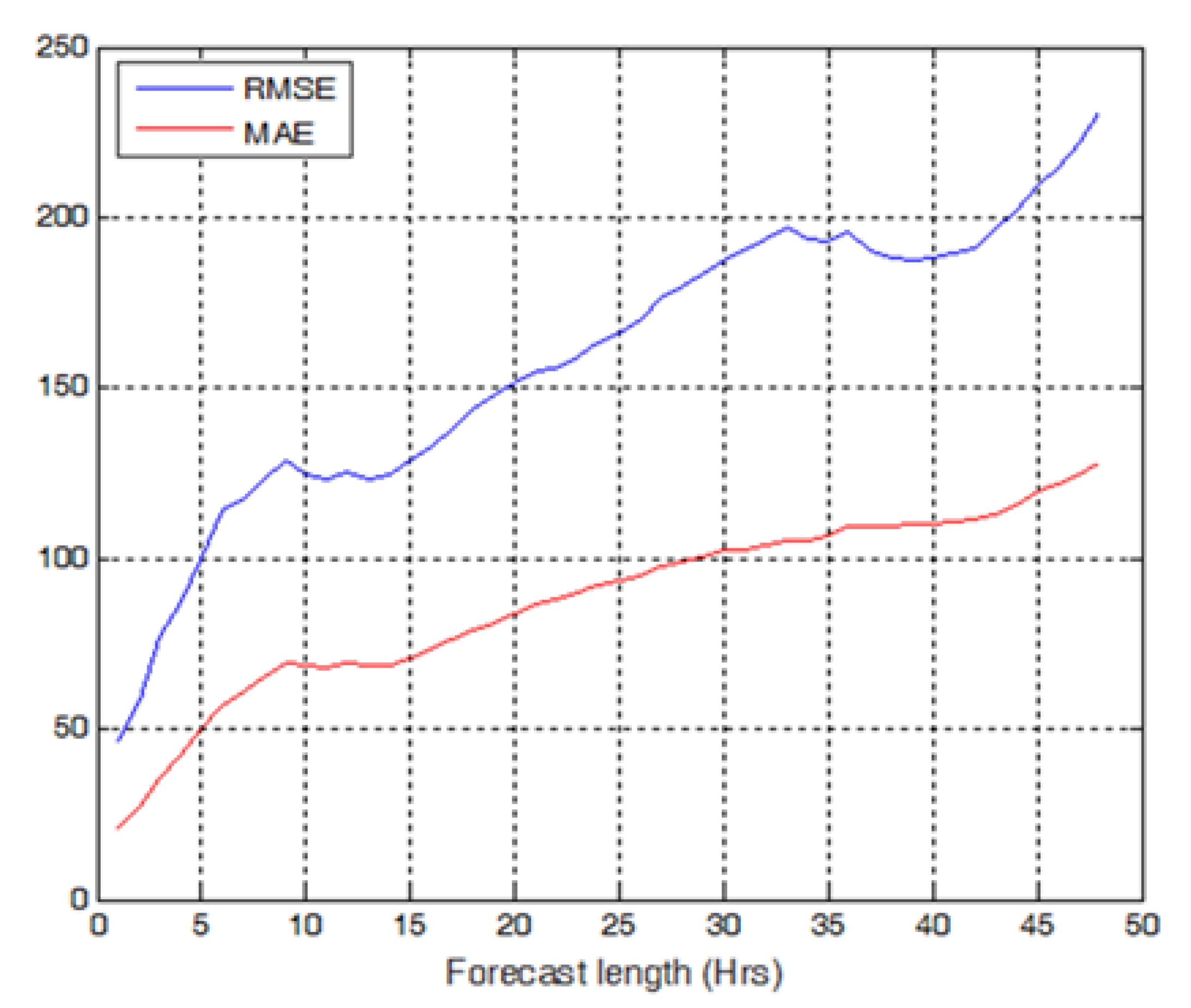
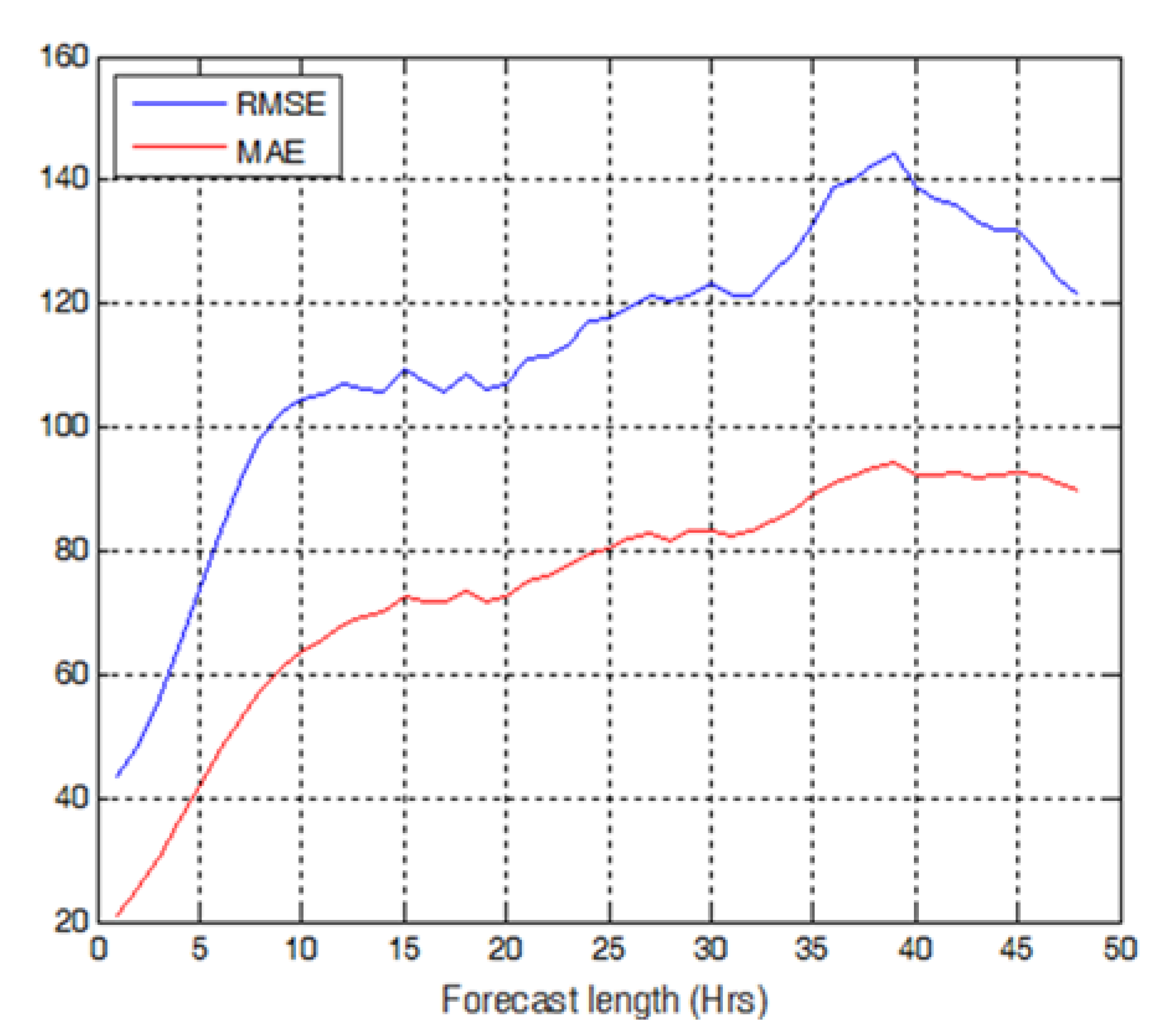
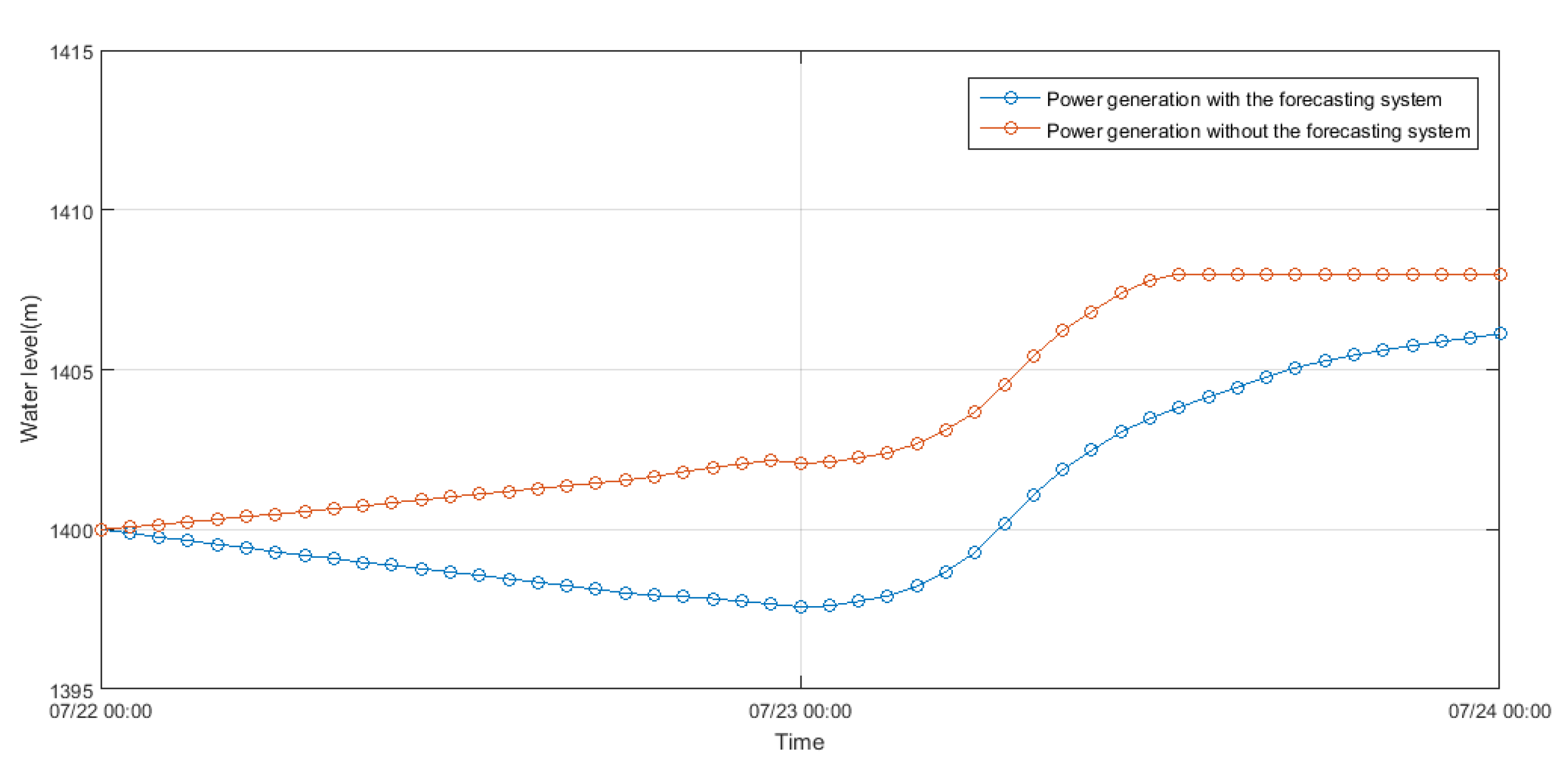
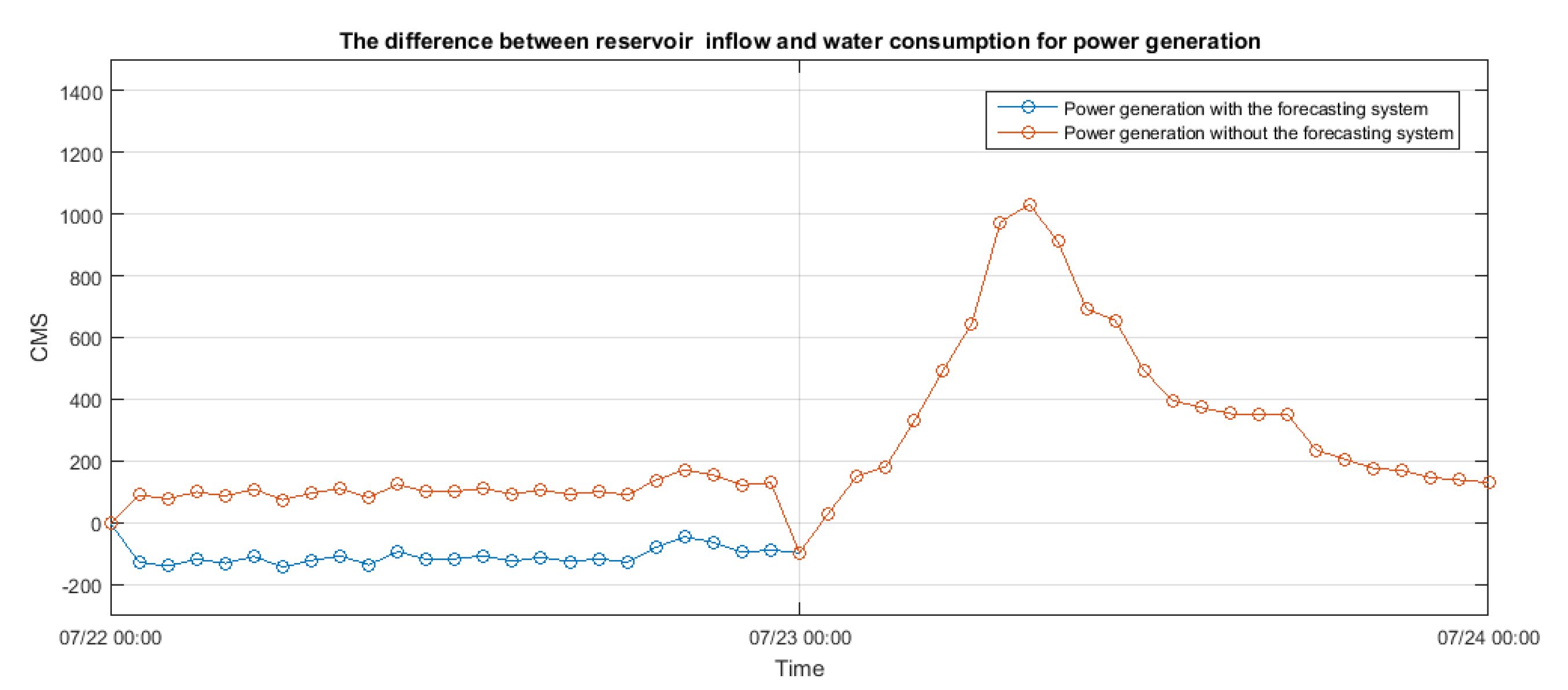
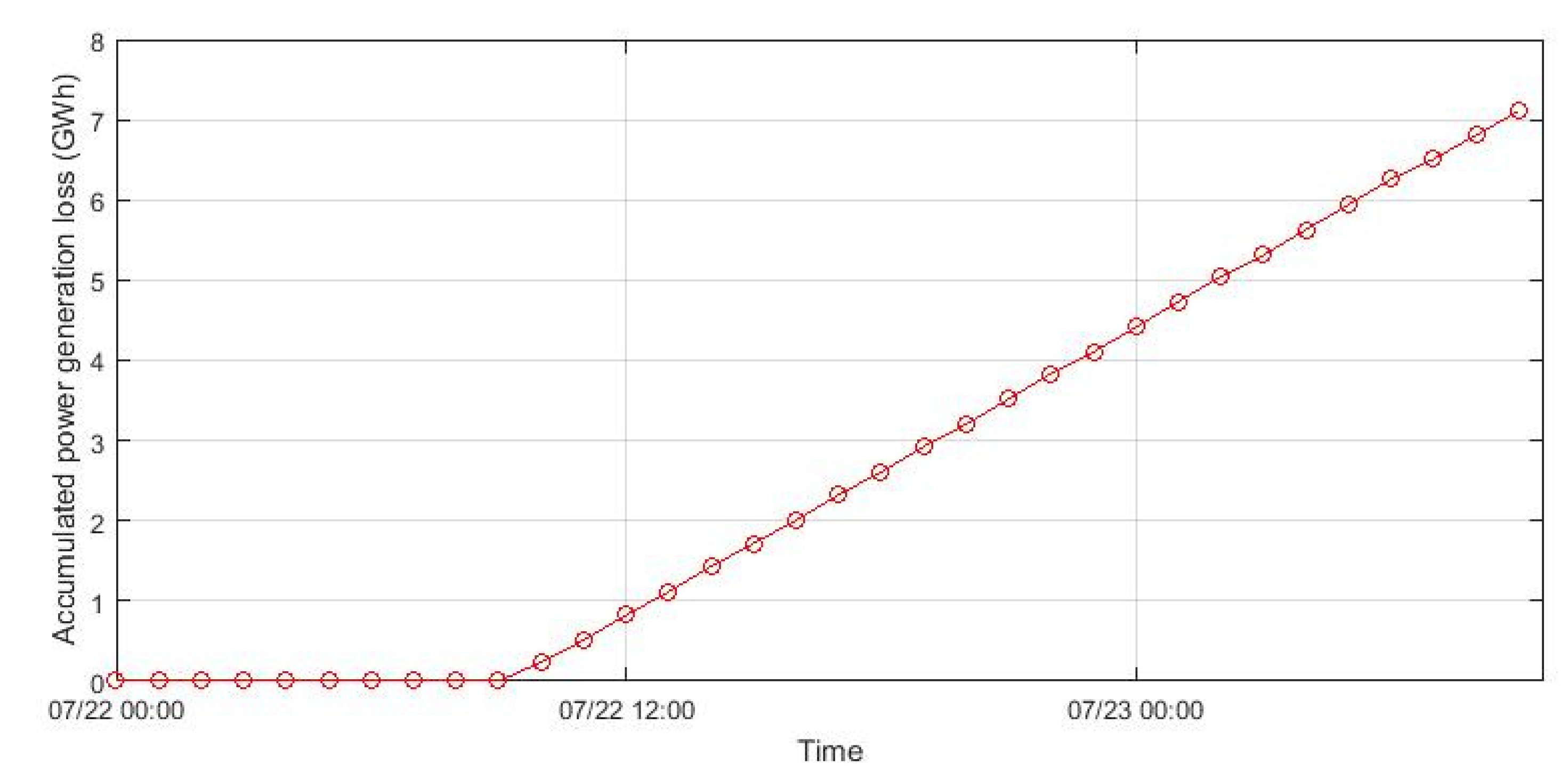
| Lead-Time (Hour) | t + 1 | t + 2 | t + 3 | t + 4 | t + 5 | t + 6 |
|---|---|---|---|---|---|---|
| MSE | 0.0437 | 0.0558 | 0.0825 | 0.1229 | 0.1724 | 0.2078 |
| Typhoon Name | During Typhoon Landing | Typhoon Intensity | Maximum Wind Speed of Central Pressure (m/s) |
|---|---|---|---|
| Matmo | 21 July–23 July 2014 | middle typhoon | 38 |
| Hagibis | 14 June–15 June 2014 | light typhoon | 20 |
| Fitow | 4 October–7 October 2013 | middle typhoon | 38 |
| Usagi | 19 September–22 September 2013 | strong typhoon | 55 |
| Kongrey | 27 August–27 August 2013 | light typhoon | 25 |
| Trami | 20 August–22 August 2013 | light typhoon | 30 |
| Cimaron | 17 July–18 July 2013 | light typhoon | 18 |
Publisher’s Note: MDPI stays neutral with regard to jurisdictional claims in published maps and institutional affiliations. |
© 2021 by the authors. Licensee MDPI, Basel, Switzerland. This article is an open access article distributed under the terms and conditions of the Creative Commons Attribution (CC BY) license (https://creativecommons.org/licenses/by/4.0/).
Share and Cite
Tsao, H.-H.; Leu, Y.-G.; Chou, L.-F.; Tsao, C.-Y. A Method of Multi-Stage Reservoir Water Level Forecasting Systems: A Case Study of Techi Hydropower in Taiwan. Energies 2021, 14, 3461. https://doi.org/10.3390/en14123461
Tsao H-H, Leu Y-G, Chou L-F, Tsao C-Y. A Method of Multi-Stage Reservoir Water Level Forecasting Systems: A Case Study of Techi Hydropower in Taiwan. Energies. 2021; 14(12):3461. https://doi.org/10.3390/en14123461
Chicago/Turabian StyleTsao, Hao-Han, Yih-Guang Leu, Li-Fen Chou, and Chao-Yang Tsao. 2021. "A Method of Multi-Stage Reservoir Water Level Forecasting Systems: A Case Study of Techi Hydropower in Taiwan" Energies 14, no. 12: 3461. https://doi.org/10.3390/en14123461
APA StyleTsao, H.-H., Leu, Y.-G., Chou, L.-F., & Tsao, C.-Y. (2021). A Method of Multi-Stage Reservoir Water Level Forecasting Systems: A Case Study of Techi Hydropower in Taiwan. Energies, 14(12), 3461. https://doi.org/10.3390/en14123461






